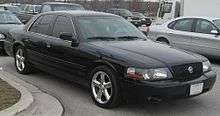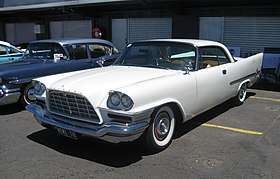Sleeper (car)
A sleeper (US English) or Q-car (British English) is a car that has high performance and an unassuming exterior.[1][2][3] Sleeper cars are so called because their exterior looks similar or identical to a standard or economy-class car. In some cases the car appears worse due to seeming neglect on the owner's part, typically referred to as "all go and no show". While appearing to be a standard or neglected car, internally they are modified to have higher performance levels. The American nomenclature comes from the term sleeper agent, while the British term derives from the Q-ships used by the Royal Navy.

In the February 1963 Motor Sport magazine editor Bill Boddy said "the modifications carried out by Lotus have turned the Lotus Cortina into a 'Q' car par excellence". The British film The Long Arm (film) (1956; aka The Third Key) mentions a Q car (unmarked) patrolling the city by night, indicating that the term was in use among UK law enforcement at least a decade earlier.
In July 1964, British magazine Motorcycle Mechanics carried an announcement from editor Bill Lawless of the use of two police 'Q–cars' – a black Daimler SP250 sports car and a green Austin A40 Farina – patrolling the A20 road between London and Maidstone, Kent.[4]
Beginnings

The Chrysler 300 letter series began in 1955 with the Chrysler C-300.[5] With a 331 in³ (5.4 L) FirePower V8, the engine was the first in a production passenger car to be rated at 300 hp (220 kW), and was by a comfortable margin the most powerful in American cars of the time. By 1957, with the 300C, power was up to 375 hp (280 kW). These cars were among the first sleepers, marketed as high-end luxury cars from the traditional luxury marque Chrysler, but with a high-end homologation racing engine. However, these cars lose their "sleeper value" due to both their rarity (this series was highly luxurious; it was made in limited numbers and examples are very expensive), and the well publicized successes of Carl Kiekhaefer in NASCAR racing (1955–1956); though the model is an important precursor of the muscle car.
The Mercedes-Benz 300SEL 6.3 was a powerful sedan with a subdued exterior.[5][6] A trend of overtly powerful saloon cars with subtle body modifications is exemplified by the work of Mercedes-AMG and Brabus on unassuming Mercedes saloons.
The Lancia Thema 8.32, fitted with a Ferrari V8 engine, has been described by Road & Track as "one of the weirder sleepers to come out of the 1980s".[7]
The car which is most often credited as the start of the production Q-car trend in Europe is the Lotus Omega, which started out as an Opel Omega/Vauxhall Carlton.[5]
Owner-modified cars
Some vehicle owners create sleepers by swapping more powerful engines[8] or making other performance modifications, like adding supercharging or turbocharging, leaving the external appearance as it came from the factory. Sometimes hints of the car's true nature are visible: wider tires, a lower stance, or a different engine tone or exhaust note. Gauges and instrumentation are often kept to a minimum. Some owners go as far as to use weight reduction techniques employed by other performance enthusiasts, removing items not fundamental to street racing, such as rear seats, trim, spare tire, air conditioner, power steering, or heater; bumpers and headlights may also be replaced with lighter items.
In some countries, customized sleeper vehicles (as with other heavily modified street cars) may be considered illegal for road use because the car's level of performance is higher than intended by the vehicle manufacturer; if the owner has focused only on straight-line performance, the existing braking, steering, tires, and suspension systems may have been rendered inadequate. The emissions control system (such as intake and exhaust restrictions or the EGR system) is often bypassed or removed entirely in customized sleeper vehicles.
Owners sometimes reduce the evidence that their high-performance car is such by removing characteristic badging. Sleeper cars often contain stock body work and wheels found on their less-capable brethren to better blend with other traffic and appear unassuming. Some owners simply like having performance without show, but a more predatory use of the sleeper is in street racing, where it is used to fool an opponent into underestimating a car's performance for the purposes of "hustling". Some have even gone so far as to leave their cars' exteriors banged up and rusting and sometimes even causing additional rusting with the use of battery acid. Often older cars from the 1930s to 1970s could look like restored stockers but with uprated drivetrains, including suspension and brakes as well as engine swaps. These are closely related to resto rods and rat rods.
Sometimes sleepers will be cheaper to insure when compared to an equally fast sports car, but some insurance companies may refuse coverage to owners of heavily modified vehicles.
Electric cars
While many Q-cars are powered either by ethanol or petrol, Tesla, Inc. can also be credited with their saloon, the Model S. The P85D Ludicrous variant can hit 0-60 in 3.1 seconds, with a top speed of 130mph (210km/h). Later models with larger battery packs of 90 and 100kWh can hit 0-60 in 2.3 seconds (one-foot rollout included), and have a top speed of 155mph (250km/h).
References
- Rodrez. "1994 Honda Accord EX - Sleepers: A Modern Day Wolf In Sheep's Clothing". Honda Tuning Magazine. 2010-09-07. Retrieved 2011-05-25.
- "Sport Compact Car Terms & Phrases - Information". Modified. Retrieved 2011-05-25.
- Robert Genat. Chevrolet SS. MotorBooks International. pp. 59–. ISBN 978-1-61060-862-6.
- Motorcycle Mechanics, July 1964, p.3. To deter or detect? "If you drive down the A20 between London and Maidstone, keep a careful eye on the four–wheel boys ... Because there are several police patrols in the area disguised as normal vehicles. Watch out particularly for a black daimler SP250 sports car and a green Farina A40 ... I've no doubt that these police 'Q-cars'—the Daimler particularly—pick up dozens of offenders every day ... Everyone concerned in any way with motoring should clamour against 'Q-cars' and hidden radar traps, too." Accessed 2014-02-16
- Jamie Kitman (2012-04-05). "Q-Car Queue: The Best Automotive Sleeper Agents". GQ.
- Gavin Braithwaite-Smith (2015-11-27). "Stealth weapons: the 101 best Q-cars of all time". MSN Cars.
- Brian Silvestro (2019-08-06). "Fly Under the Radar With This Ferrari-Engined '80s Lancia Sedan". Road & Track.
- Hasson, Randy (April 2010). "Hybrid How-To: CB/CD (4G/5G) Accord Chassis with H22 Engine". Modified. Retrieved 2011-05-25.